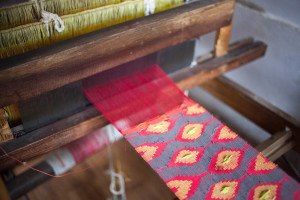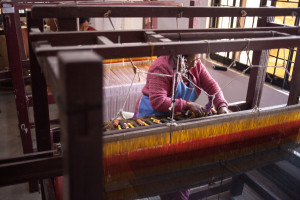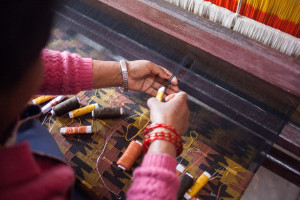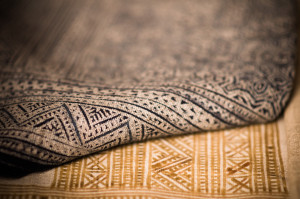Our Materials
We incorporate traditional handloom in most of our products as a way to promote and preserve local artisans and their traditions. The name of the traditional handloom fabric that comes from Nepal is called “dhaka”.
What is “dhaka”?
Dhaka is the name of a beautifully handcrafted fabric that stems Nepal, and is created on a handloom through a tradition that dates back centuries. Hundreds of years ago, dhaka fabric was often was created in the homes of Nepali families. Today, the fabric is still deeply woven into Nepali culture – it is often worn at the most important life-ceremonies such as weddings, and probably the most visible sign of dhaka fabric is on the traditional Nepali hat that you can find most men wearing around Nepal, the dhaka topi. Dhaka incorporates beautiful traditional colors and patterns. Its significance is steeped in history and art, it is a proud tradition and heritage, and is truly a symbol of Nepal.



 Organic Cotton is known as the most skin-friendly, soothing and harmless natural fiber on the plant.
Organic Cotton is known as the most skin-friendly, soothing and harmless natural fiber on the plant.
What is Organic Cotton?
In simple terms, organic cotton is grown without the use of toxic pesticides or fertilizers. But when you look deeper it is so much more that that! Organic cotton is grown on land that has been given sufficient time, at least three years, for the removal of all the previously used toxic residues of chemical fertilizers and pesticides. The cotton is from original, naturally grown plants, meaning no genetic modification takes place, and the plants have not been treated with any chemicals during its processing and packaging.
The Environment
Nearly 25 percent of the world’s insecticide use, and more than 10 percent of the world’s pesticide goes to cotton crops. In 2003, that amounted to about 55 million pounds of pesticides being sprayed on 12.8 million acres of cotton, according to the Organic Trade Association. Some of these chemicals are considered to be the most toxic chemicals in the world. The health risks of pesticide exposure include birth defects, reproductive disorders and weaker immune systems.
You
Besides helping the environment, there are other benefits from organic cotton products. Working environments are better for those on farms and small-scale farmers save money by not having to buy large amount of pesticides. Consumers benefit too, as organic cotton products are softer and easier on your skin.
 Hemp is the longest and strongest natural fiber known to man, and its use dates back to 8,000 b.c.
Hemp is the longest and strongest natural fiber known to man, and its use dates back to 8,000 b.c.
What is Hemp?
Hemp is a variation of cannabis sativa. It is the most useful plant known to mankind. Literally, we mean it! (sativa=useful). Let’s be clear, because we know you are all are wondering, hemp is not marijuana.
The Benefits of Hemp
Hemp grows fast. Unlike cotton, which takes an entire season to grow and mature, hemp matures extremely quickly. This means that farmers can get harvests faster, making more of a profit each year. What is even better? Hemp doesn’t require costly pesticides. Hemp naturally resists insects and fungus. It also naturally suppresses weed growth. Farmers don’t have to spend a fortune on dangerous chemicals and we are all safer. *Sigh* of relief.
Did you know that hemp also decreases pollution? This wonder plant actually cleans up toxins in the surrounding soil through a process called phytoremediation. Want a good example? Hemp was planted around the Chernobyl disaster site to clean up the radiation.
Hemp blocks UV rays, which is yet another advantage when used in fabrics. It blocks 50% more UV rays than regular cotton fabrics. It rapidly absorbs moisture making it cool and comfortable, and over time, hemp becomes softer without losing its shape or appearance. These qualities make hemp fabrics the perfect for travelers and beach lovers.
The hemp (Allo) plant that we use in our products occurs in most of the high mountain regions of Nepal at the altitudes of 1,400 – 4,000 meters. It is traditionally woven into cloth in an open back strap loom. The handcrafted nature of this product will produce minor differences in color and sizing. Subtle shade variations will occur from piece to piece, adding to its unique qualities and making it truly one of a kind.
